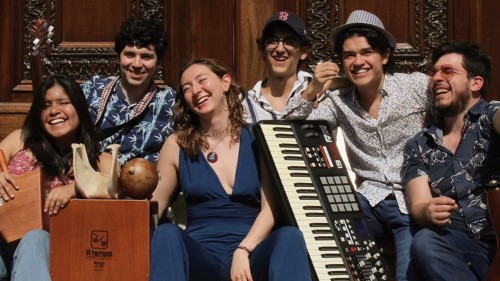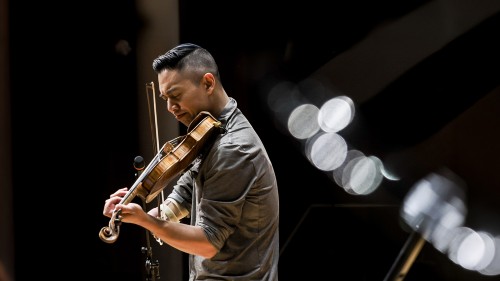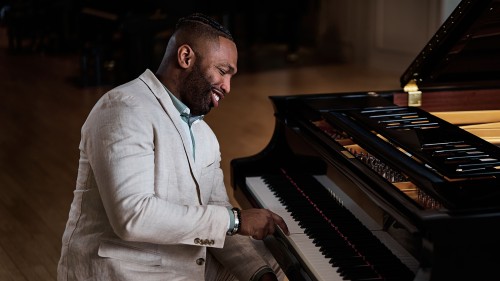
Sérgio Assad, Clarice Assad, & Third Coast Percussion
ARCHETYPES: 12 New Works Exploring Stories That Connect Us All
Cookie Notice
This site uses cookies to measure our traffic and improve your experience. By clicking "OK" you consent to our use of cookies.
Half of the renowned guitar duo The Assad Brothers, Sérgio Assad, joins his daughter, pianist and composer Clarice Assad, one of the most widely performed Brazilian concert music composers of her generation, and the Grammy-winning percussion ensemble Third Coast Percussion (who made their Series debut on our Stave Sessions lineup) for a unique and fascinating pan-cultural journey.
This concert will explore the universal symbolic archetypes that appear in stories, legends, and myths throughout the world—great floods, creation, paradise, apocalypses—as well as characters that appear in stories across cultures. With Archetypes, the ensemble of guitar, piano, voice, and percussion quartet will take the audience on a global musical journey grounded in familiar stories.
From Third Coast Percussion, about Archetypes:
This project explores the universal symbolic archetypes that appear in stories, legends, and myths throughout the world. Archetypes bind all of us together through our shared connection to these fundamental aspects of the human experience. In storytelling, an archetype can be a character, a setting, a theme, or it can even be a particular outcome. This may explain how stories that originate from vastly different cultures across the globe can, at their core, so closely resemble one another.
Expressing themselves through guitar, voice, piano, and a battery of percussion instruments, the ensemble draws inspiration from these foundational aspects of the human experience, as well as an array of musical traditions, taking the audience on a far-reaching musical journey grounded in familiar stories.
Media partner ![]()
Videos

Archetypes

Archetypes: Sérgio and Clarice Assad in rehearsal with Third Coast Percussion

Sérgio and Odair Assad play Albéniz: Córdoba, from Cantos de España Op. 232, No. 4

Clarice & Sergio Assad: Beatriz (by Edu Lobo & Chico Buarque)

Third Coast Percussion: NPR Music Tiny Desk Concert

Archetypes

Archetypes: Sérgio and Clarice Assad in rehearsal with Third Coast Percussion

Sérgio and Odair Assad play Albéniz: Córdoba, from Cantos de España Op. 232, No. 4

Clarice & Sergio Assad: Beatriz (by Edu Lobo & Chico Buarque)

Third Coast Percussion: NPR Music Tiny Desk Concert
Notes on the Program
This collaboration of Chicago-based artists has its origins, fittingly, from the Ear Taxi Chicago Festival of New Music. Clarice and Sérgio Assad saw Third Coast Percussion’s performance at this unique festival in 2016, and reached out to discuss a possible collaboration. The members of Third Coast were also admirers of the Assads, and were excited for a project that would open new possibilities for all of these artists, who love to both perform and compose. The theme of “archetypes” evolved out of an earlier idea of “myths and legends,” both of which would explore the idea of universal elements that appear across different traditions.
Archetypes are generally considered standard character types that recur in many different types of stories, but that character can be defined by their personality, job, talents, or the role they play in the story. The concept is most immediately applicable to literature, film, and other forms of storytelling, but it creates a lens through which to view human nature which has fascinated philosophers, psychologists, business people, and others.
While a single archetype will appear across many stories, the wonder of archetypes is to experience the different ways that each culture, tradition, or author creates variations of an identity—rich characters that go beyond the archetype, and who may at times contradict the assumptions the audience makes about such a character. Specific popular characters can even start to become archetypes of their own; think about all the versions of fictional figures like Batman, James Bond, or Romeo & Juliet that have emerged over the years. These variations often spur conversations—sometimes very heated—about what characteristics define a figure, and what are flexible.
The Swiss psychologist Carl Jung popularized the view of archetypes as a window into human behavior, understanding each of these character types as a “living system of reactions and aptitudes that determine the individual’s life in invisible ways.” Jung proposed that these archetypes live in our collective unconscious, that the common understanding of what makes a “caregiver” or a “hero” creates a reference point by which all people measure their own identity, and the identities of others. This, in turn, has led thinkers from other fields to consider archetypes as useful tools for predicting or shaping human behavior. The particular list of twelve archetypes that served as the inspiration for the music in tonight’s performance have also been used as a tool in the business world. Margaret Mark and Carol S. Pearson use this collection of archetypes in their book “The Hero and the Outlaw: Building Extraordinary Brands Through the Power of Archetypes.”
There is no set number of archetypes; some lists include more than 300, but people have made their own shorter lists by grouping them in different ways, or selecting a subset that has the greatest use for their purpose. This list of twelve resonated with us because it represented distinctly different characters which felt very familiar from stories and real people. We have all known individuals who we considered rebels, jesters, or sages, and we have all inhabited each of these identities ourselves at different moments in our lives. There was a pleasing symmetry and balance to a group of twelve identities as well, paralleling other practical and spiritual groupings of twelve, such as zodiac signs and measures of time.
Each of the performers chose certain archetypes that sparked our imaginations, with Clarice and Sérgio each composing four of the movements, and each member of Third Coast Percussion composing one. The vast color palette available to a percussion quartet, combined with Clarice’s versatile musicianship as a multi-instrumentalist and vocalist (including work with electronic processing of her voice), and Sérgio’s unparalleled mastery of the guitar, allowed opportunities to paint vivid pictures inspired by each of these archetypes.
Just as the archetypes are abstract enough to allow for infinite variation, it is our hope that the wordless music on this program will capture the spirit of each of these archetypes while allowing each audience member’s associations and imaginations to lead to their own unique listening experience. It has been a joy to collaborate to bring this new music into the world, and we’re thrilled to share it with you today.
About Sérgio Assad:
Sérgio Assad is a world-renowned classical guitarist, composer and teacher who has greatly impacted the modern classical guitar world through brilliant performances, compositions and teachings.
He first made an impression on the world of classical guitar through the remarkable performances of the celebrated Duo Assad, featuring him and his brother (also known as the Assad Brothers). Their acclaimed performances not only deliver sophisticated and profound interpretations of the traditional classical repertoire, but they also enlarged significantly the possibilities of the classical guitar through exceptional arrangements and original compositions that have bridged musical styles and cultural boundaries.
Beginning with arrangements and compositions for their guitar duo, Assad has since augmented his impact as a recognized composer for a wide range of chamber music and orchestral formations. His works are frequently performed, from solo guitar pieces which are now standards in classical guitar recitals and competitions, to large orchestral pieces which have been recorded by a number of leading music interpreters of our times including recordings by most of the leading classical guitarists.
His music also has been recorded in collaborations of the Duo Assad with a long list of renowned classical and jazz artists including Yo-Yo Ma, Dawn Upshaw, Nadja Salerno-Sonnenberg, Gidon Kremer, the Turtle Island Quartet and Paquito D'Rivera.
Assad has received two Latin Grammys, one for his composition "Tahhiyya Li Ossoulina" in 2008 and one for the album "Sérgio and Odair Assad Play Piazzolla" in 2002. His recordings and compositions have had numerous nominations, including two in 2010 for Latin Grammy Best Classical Contemporary Composition for his guitar duo piece "Maracaípe" (recorded by the Beijing Guitar Duo) and his concerto for guitar quartet and orchestra "Interchange" (recorded by the LA Quartet).
About Clarice Assad:
A powerful communicator renowned for her musical scope and versatility, Brazilian American Clarice Assad is a significant artistic voice in the classical, world music, pop and jazz genres, renowned for her evocative colors, rich textures, and diverse stylistic range. A prolific Grammy nominated composer, with over 70 works to her credit, her work has been commissioned by internationally renowned organizations, festivals and artists, and are published in
France (Editions Lemoine), Germany (Trekel), Criadores do Brasil (Brazil) and in the US by Virtual Artists Collective Publishing. A sought-after performer, she is a celebrated pianist and inventive vocalist. Ms. Assad has released seven solo albums and appeared on or had her works performed on another 30. Her music is represented on Cedille Records, SONY Masterworks, Nonesuch, Adventure Music, Edge, Telarc, NSS Music, GHA, and CHANDOS. As an innovator, her award-winning Voxploration Series on music education, creation, songwriting and improvisation has been presented throughout the United States, Brazil, Europe and the Middle East. With her talents sought-after by artists and organizations worldwide, the multi-talented musician continues to attract new audiences both onstage and off.
About Third Coast Percussion:
David Skidmore
Robert Dillon
Peter Martin
Sean Connors
Third Coast Percussion is a Grammy-winning, artist-run quartet of classically-trained percussionists hailing from the great city of Chicago. For over ten years, the ensemble has forged a unique path in the musical landscape with virtuosic, energetic performances that celebrate the extraordinary depth and breadth of musical possibilities in the world of percussion. The ensemble has been praised for “commandingly elegant” (New York Times) performances, the “rare power” (Washington Post) of their recordings, and “an inspirational sense of fun and curiosity” (Minnesota Star-Tribune). The four members of Third Coast are also accomplished teachers, and from 2013-2018 served as ensemble-in-residence at the University of Notre Dame’s DeBartolo Performing Arts Center.
A direct connection with the audience is at the core of all of Third Coast Percussion’s work, whether the musicians are speaking from the stage about a new piece of music, inviting the audience to play along in a concert or educational performance, or inviting their fans around the world to create new music using one of their free mobile apps.
Third Coast Percussion maintains a busy touring schedule, with past performances in 33 of the 50 states plus Canada, Germany, Italy, the Netherlands, and Poland, and venues ranging from concert halls at the Metropolitan Museum of Art and De Doelen to clubs and alternative performance spaces such as New York’s Le Poisson Rouge and the National Gallery’s West Garden Court.
The quartet’s curiosity and eclectic taste have led to a series of unlikely collaborations that have produced exciting new art. The ensemble has worked with engineers at the University of Notre Dame, architects at the Frank Lloyd Wright Foundation, dancers at Hubbard Street Dance Chicago, and musicians from traditions ranging from the mbira music of Zimbabwe’s Shona people, to indie rockers, to some of the world’s leading concert musicians.
A commission for a new work from composer Augusta Read Thomas in 2012 led to the realization that commissioning new musical works can be – and should be – as collaborative as any other artistic partnership. Through extensive workshopping and close contact with composers, Third Coast Percussion has commissioned and premiered new works from Philip Glass, Devonté Hynes, Donnacha Dennehy, Glenn Kotche, Lei Liang, Gavin Bryars, Christopher Cerrone, Marcos Balter, and today’s leading up-and-coming composers through their Emerging Composers Partnership Program. These works have become part of the ensemble’s core repertoire and seen hundreds of performances across North America and throughout Europe.
Third Coast Percussion’s recordings include eight full-length albums, three EPs, and a number of appearances on other releases. The quartet has put its stamp on iconic percussion works by John Cage, Steve Reich, and Philippe Manoury, and Third Coast has also created first recordings of commissioned works by Philip Glass, Augusta Read Thomas, David T. Little, and Ted Hearne, in addition to recordings of the ensemble’s own compositions. In 2017 the ensemble won the Grammy Award for Best Chamber Music/Small Ensemble performance for their recording of Steve Reich’s works for percussion.
Third Coast Percussion has always maintained strong ties to the vibrant artistic community in their hometown of Chicago. They have collaborated with Chicago institutions such as Hubbard Street Dance Chicago, the Chicago Philharmonic, and the Adler Planetarium, performed at the grand opening of Maggie Daley Children’s Park, conducted residencies at the University of Chicago, Northwestern University, and the Civic Orchestra of Chicago, created multi-year collaborative projects with Chicago-based composers Augusta Read Thomas, Glenn Kotche, and chamber ensemble Eighth Blackbird, and taught tens of thousands of students through partnerships with The People’s Music School, Urban Gateways, the Chicago Park District, Rush Hour Concerts, and others.
The four members of Third Coast Percussion met while studying percussion music at Northwestern University. Members of Third Coast also hold degrees from the Eastman School of Music, Rutgers University, the New England Conservatory, and the Yale School of Music. Stay up-to-date and go behind-the-scenes by following Third Coast on Twitter (@ThirdCoastPerc), Facebook (@Third Coast Percussion), and Instagram (@ThirdCoastPercussion).
Artist Websites
Related Events


Kalia Vandever, trombone & Charles Overton, harp

Adrian Anantawan & Friends

John Paul McGee Jazz Trio

J’Nai Bridges, mezzo-soprano

Music From The Sole
House is Open, Going Dark
Stay in touch with Celebrity Series of Boston and get the latest.
Email Updates Sign up for Email Updates